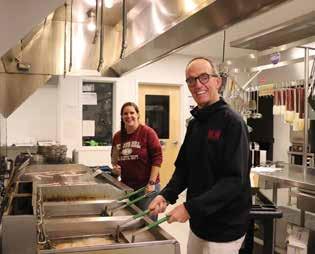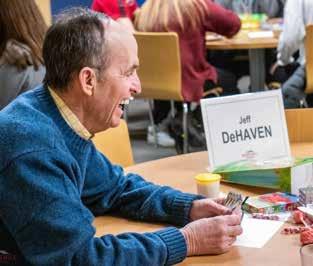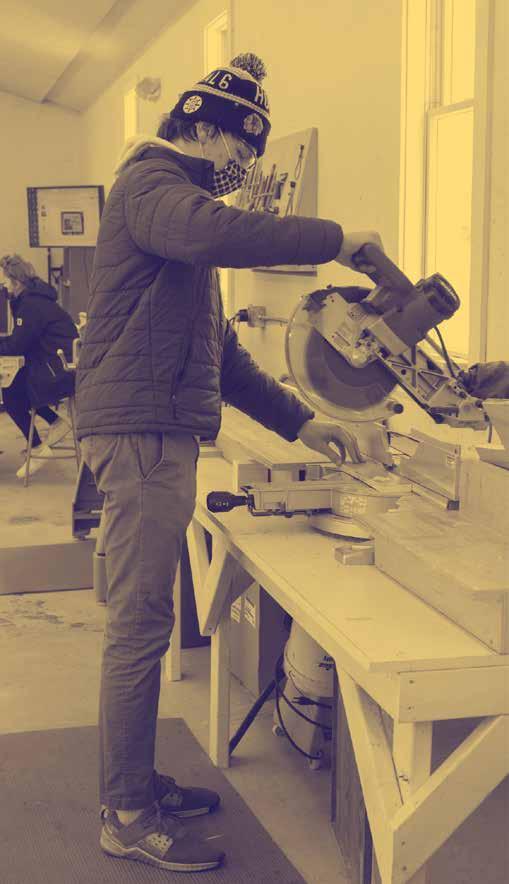
14 minute read
What Should We Eat?
A Kents Hill Life
We began to write a piece about the incomparable Jeff DeHaven for this issue of Kents Hill Today, but true to form, he bested us! He went “all-in” and wrote his own! We honestly think he did a wonderful job (which is not surprising as he is frequently called “favorite teacher” by many alumni), so without further adieu, we introduce you to a man who to most, needs no introduction... the myth, the teacher, the coach, the legend—“DeHave.”
Words by Jeff DeHaven
When Eric Eisele ‘99 was in his senior spring, I repeatedly gave him a hard time about being out of dress code. One day, I’d had just about enough, so I kind of went off on him. “Eric!” I said. “I’m not gonna tell you again, you HAVE TO BE IN DRESS CODE!!!” Eric replied, “Why you gotta be like that?!! I just got back from tutoring kids at the Fayette School and we don’t have to be in dress code there!” I felt really foolish, but I learned a valuable lesson. From that day forward, I tried to lead with a question rather than a value judgement. So, my “go-to” became, “how come you’re not in dress code?” instead of “you have to be in dress code!” Or “why didn’t you make it to class today?” instead of “you missed another class!” Or “why are you late?” instead of “If you’re late again, you’re gonna get a cut!” Or “why didn’t you get your homework done,” or “why didn’t you do well on the test?” As a teacher and coach at Kents Hill, I was always learning from students and as an administrator and faculty member, I got to share those lessons with other teachers.
I always felt that as a Kents Hill teacher, I was a little different from teachers at other schools. Whether I was 34 or 64, I grew older each year, but my students always stayed the same age. However, I learned that all good teachers, as the years go by, change for the better. For example, as a young teacher, I was positive that I had to strive for consistency, but as I gained experience I concluded that “consistency” means different things to different people. Benjamin Disraeli said that “the secret to success is consistency,” but Aldous Huxley said, “the only truly consistent people are dead.” Joseph Conrad said that “consistency is the very soul of discipline,” but Ralph Waldo Emerson said that “consistency is the hobgoblin of small minds.” Francis Bacon said “consistency is the foundation of all virtue,” but Oscar Wilde said that “consistency is the last refuge of the unimaginative.” For my part, I’m not sure that it’s the “foundation of all virtue,” but when I was consistent, I knew I wasn’t dead, and I didn’t think that I was “completely unimaginative.” There was undoubtedly some middle ground, and as a teacher at Kents Hill, it was my job to try to find it. Kids, teenagers, in particular, have an acute sense of justice, so they demanded that I be consistent. However, there were often extenuating circumstances that I had to take into consideration that
frequently made me forget about consistency. With my students, it was often a crisis. What if no one likes me? What if my parents get divorced? What if I don’t grow anymore? What if my teeth aren’t straight? What if I flunk a test? What if I start to cry? What if I get beat up? What if I’m dumb (or if someone implies that I am)? It’s growing up and it’s sometimes hard for adults to remember the specific trials and tribulations that go with it.
However, because I got older and my students didn’t, I tried to remember! Whenever I spent time with my advisees, with the kids in the dorms, with the kids I coached, and with the kids who were in my classes, I always thought we were doing important stuff. Sure, I wanted Kents Hill students to be scholars, but I really wanted them to be honest, so I tried to be willing to admit my mistakes (god knows I made my share), I wanted them to be good sports, so I tried to treat them fairly, I wanted them to be altruistic, so I tried to give them my time, and I wanted them to persevere, so when they weren’t reaching their potential, I tried to find out why. Certainly, science and math and English and history and art and languages are important, but I always thought that the most important things that I taught went well beyond the classroom. Teaching kids to make good decisions, to listen to one another, to respect one another and themselves, to empathize with one another, and to be kind and generous with one another, these were the main concerns of Kents Hill while I was a teacher, coach, and administrator and that is another reason that I stayed at Kents Hill for so long.
That is what sets Kents Hill apart…the willingness of the faculty and the students to persevere and teach and learn from one another make it a great school. For example, I can pick almost any kid, past or present, to prove my point. Craig Cole, Aaron Ramert, Casey Cummings, Caroline Gray, Florence Lert and the Howe boys, Jeff and Mike all from the class of ‘92 are better people for having been at Kents Hill; those who taught them are better people for having
had the experience. The same goes for the Class of ’02 with Warren Reid, Jen Macomber, Lee Andrews, Charlie Chiang, Lydia Joseph, and Ko Iwamoto. Or how about Xander Shaw, Sarah Adams, Cam Dow, Lauren Farnsworth, David Bacon, Anna Bigelow, and Brandon Bourgeois from the Class of ’12 or Jack Bonnefond, Amita Nanda, Jackson Melendy, Naema O’Rourke, Alanna Bachelder, Aaron Jones, and Kunseo Yuk from the Class of ’22. However, it’s not just the kids who first come to mind. Try it. Name a friend, teacher, or classmate and you’ll see. We are all better people for having been here. It’s a wonderful circle that keeps on repeating itself. From the mayhem of Maine Hall in ‘87 to the COVID-crazy year of ’21, it has been a great run for me. I loved coaching girl’s tennis and boy’s hockey and teaching classes and being Dean of Faculty all at the same time or coaching boy’s tennis and hockey and teaching classes and being Academic Dean and Director of College “ I learned that all good Counselling at the same time. It never felt like a job. As a matter of fact, it was teachers, as the years go often so much fun by, change for the better.” that I couldn’t believe that I was getting paid to do it. I hope the teachers here will always be the coaches and advisors and administrators. The best connections I made with students were with kids that I taught and coached and advised. The best connections I made with colleagues were when, as an administrator, I continued to coach major sports and teach multiple classes and be an advisor, because I knew, like they did, what it was like to never have enough hours in the day to get it all done. However, to be a part of a community where everyone worked incredibly hard and had so much fun, was exhilarating. I also loved the democratic nature of Kents Hill. For many years, all of our faculty meetings were in the round (it always made me think of King Arthur the Knights of the Round Table) which made it possible for everyone, from the newest teacher to the wiliest veteran, to have a say in what happened in our school and in our community. And finally, that’s what made being at Kents Hill possible for me. I always knew that my opinion mattered, that I would be heard, and that I, like every student, staff member, and faculty member would be treated like an individual. I always knew that I was a part of something bigger than myself and that what I thought mattered to the school and the community.
I loved teaching great books in AP English and American Literature and I had many absolutely unforgettable groups of students in both classes. However, some of my favorite classes also included Literature and The Athlete in Literature and Film because both classes were so student-centered. Going to the finals of the New England Hockey tournaments in ’08 with Josh Goellner, Brad Richards, and Brian Fleming leading our team to the championship and in ’13 with Logan Day, Jared Cockrell, and Filip Akermark leading KH to the championship game were certainly highlights. However, every year provided a new adventure! It was really the hundreds of bus rides, the trips to CT and Stanstead and Presque Isle and Houlton and New Hampton and Holderness and Hebron and Proctor and Gould for hockey and tennis that made every year, win or lose, fun and exciting. Getting on stage during winter carnival where the students made fun of the faculty, going whitewater rafting with hundreds of students, going on senior trips to Six Flags, Old Orchard Beach, Ogunquit, and Cape Cod, seeing dozens of students and teachers imitate me and having Thursday nights with the faculty provided me with some of my most cherished memories.
When I started as a teacher at Kents Hill, I thought that all of my teaching and most of my learning would take place in the classroom. However, I learned early on that most of the teaching and learning at KH takes place outside of the classroom. I learned that compassion, altruism, friendship, sportsmanship, tolerance, perseverance, courage, responsibility, and particularly honesty are every bit as important as scholarship. In the end, Kents Hill taught me that one person of principle can always make a difference. I hope that I did! ■



Community Design & Build Class Launches
a Real-World Project

Kents Hill's Four-Dimensional (4D) Academic Curriculum has long been centered in ideas like character-driven education and Project-Based Learning (PBL), but this semester, Jeff Munson, Director of Community Engagement, and Jordan Gehman, Art Department Chair, are working with the Readfield Community Library’s Librarian, Melissa Small, to bring our core value of Altruism and PBL together beyond the Kents Hill campus.
Munson says, “This project is unique in that it is the first time we are using an engagement project inside a classroom environment as a part of the curriculum. Jordan and his students have been able to take this need from the Library and turn it into a really cool PBL opportunity. I have wanted to find projects or topics that classroom teachers could use within their curriculum and would still have a positive impact on our greater community and this is exactly what we have been looking for. I love this one because we can involve a lot of people even during the pandemic.”
A Readfield Community Library StoryWalk®
The woodworking project is a StoryWalk® that will be installed behind the Readfield Community Library, which was made possible by a grant from the Let's Go program of the Healthy Communities of the Capital Area.
Back in September 2020 a temporary StoryWalk® was loaned to the Library and enjoyed by many families, and, building on the success and excitement generated by the effort, Small applied for a grant to build a more permanent community engagement piece.
Small says, “We used the StoryWalk® at the Readfield Beach during one of our weekly Story Times and the families loved it, so we asked to keep the signs longer and we moved the StoryWalk® to the trail behind the Library for others in the town to enjoy for a few weeks.”
“When I returned the StoryWalk® to Nan Bell, Let’s Go! Coordinator for Southern Kennebec County at the HCCA, and explained how people in town really enjoyed it, she suggested that we partner with the Readfield Elementary School (a ‘Let’s Go’ site) to apply for a grant that would promote physical activity and active living for children. So, we did! Readfield Community Library Board of Trustees members Pam Mitchell and Pat Clark and Readfield Elementary School nurse Jada Clark were instrumental in helping to envision what the project could be for the Readfield community and in assisting with the writing of the grant.”
The result was funding for not one, but two StoryWalk®. The first to be created by Maranacook Area School students behind Readfield Elementary School and the second by Kents Hill students behind the Library.
Planning & Prototyping
Once the grant was finalized, our Community Design & Build students began actively working on designing prototypes. Gehman divided his class into two teams and had them work on two separate design solutions for the walk. They have both produced excellent pieces that focus on things like durability, whether or not the piece was waterproof, and accessibility.
Gehman says, “As a class, we looked at the basic function and parameters of the StoryWalk® project. I.e. must be accessible for all people, must be waterproof/resistant, and how can we access and change out the pages of the books?”
“We did online research for a previous example of how StoryWalk® signage was made. We also discussed the pros and cons of various construction methods we could use to execute this project.”
Expanding Minds

We are passionate about this project because it expands the students’ perspective on engagement while teaching skills. Munson says, “Altruism plays into any community engagement project because it helps our students understand that there are needs beyond our own acreage that we can help fill. Students earn a greater perspective of what is useful in the community, and they can contribute back with no expectation of a reward, other than satisfaction for a job well done. Also, the skills that the students demonstrate fall within our 4D Curriculum goals. This project is perfect for developing creativity, critical thinking, collaboration, and communication, and they demonstrated those at every step in the process as they created and tested designs and competed for a ‘winning’ design.”
Gehman says, “Engaging students in projects that benefit the greater community is essential for the character development of this generation.”
“Students are able to problem solve real-world situations. If the students understand why we are building something they will have an easier time understanding how to build that object." Gehman continues, “We worked on and finished this project after the ground was thawed.”
Community Impact
Now that the design has been installed, we are anxious to see the reaction from the community. Small says, “People view libraries as places that nurture healthy brains through the educational and informational materials and programs they provide. Increasingly, research is showing how critical physical activity is to brain health as well as physical health, and that this is true for all stages of the lifespan. I think that the opportunity to provide the Readfield community with a permanent StoryWalk® that promotes both literacy and physical activity in children and their caregivers and provides a fun experience that families can do together outdoors on their own time right in the center of town is the epitome of an ideal Library program!”
She continues, “We hope that community members of all ages will enjoy the two StoryWalks®. We plan to change the featured story each month to keep things interesting and fresh, and we will encourage community members and businesses to sponsor a StoryWalk® by making a $40 donation to purchase the two copies of the book needed to create each monthly installation. In the future, we may have special features, such as community members’ poetry, artwork, and stories on display from time to time.”
The first story has yet to be chosen, but planning is underway. Small says, “We are working on a list possible picture books, with a focus on stories that encourage activity while reading. Two examples are ‘Clap Your

Hands’ by Lorinda Bryan Cauley and ‘Dancing Feet!’ by Lindsey Craig and Marc Brown.”
Hunting for More Engagement
Our team is always looking for more community engagement projects. Munson says, “In broad strokes, I look for community partners where we can build long-term relationships so that they understand that we are willing and able to help them achieve their goals in the community, and we know that we are partnering with organizations that are doing good work and value our participation. Ideally, I look for an education
The StoryWalk® Project was created by Anne Ferguson of Montpelier, VT, and was developed in collaboration with the Kellogg-Hubbard Library. StoryWalk® is a registered service mark owned by Ms. Ferguson. For more information visit kellogghubbard.org.
Left: Jordan Gehman and his son, Monroe working on the StoryWalk®





